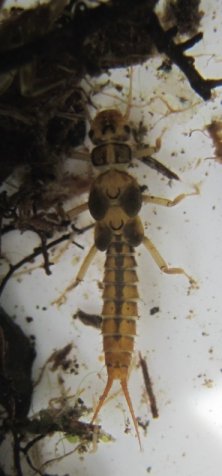| 1a. A pair of fingerlike gills (actually osmobranchiae) present on all thoracic segments and under chin (submental gills).
Even small nymphs have one gill between each leg, in about the same plane as the legs. Visible from above on big live nymphs crawling in a pan. |
 |
| 1b. No gills on thorax. Submental gills present or absent. | |
| 2a. Abdomen with longitudinal stripes. |
 |
| 2b. Abdomen not striped or with transverse stripes. | |
| 3a. Lacinia unidentate.
One tooth |
 |
| 3b. Lacinia bidentate.
Two teeth |
 |
| 4a. Mesosternal Y-arms meet or approach anterior corners of furcal pits.
Mandibles deeply cleft separating teeth into two major cusps. Submental gills present. |
  |
| 4b. Mesosternal Y-arms meet or approach posterior corners of furcal pits.
Mandibles not deeply cleft . Submental gills present or absent. |
  |
| 5a.Apical lacinial tooth nearly 1/2 the outer lacinial length.
Outermost cusp of both mandibles serrate. Mesal tufts of silky setae on occiput. Translation: Has fine setae towards the back of the head between the eyes. Abdominal segment one and two divided by pleural fold. | |
| 5b.Apical lacinial tooth over 1/3 the outer lacinial length.
Outermost cusp of mandibles unserrated or indistinctly on left side only. Occiput bare, no setae between eyes. Abdominal segment one to three divided by pleural fold. Currently not reported from Gunnison County, may be present at high elevations. |
  |
| 6a. Mesosternum with median longitudinal suture connecting fork of Y-arms with transverse suture.
You need a well-preserved, large nymph and a good microscope with bright light to see this. Put the nymph on its back and look at its belly. The mesosternum is the middle segment with legs attached. |
 |
| 6b. Mesosternum Y-arm area simpler, without median suture. |  |
| 7a. Submental gills present.
Look under the head (ventral side), check the area under the mouthparts for small fingerlike gills.
Back half of cerci dark. This is distinctive and unique among the local Perlodid stoneflies. |
  |
| 7b. No submental gills. |  |
| 8a. Inner lacinial tooth with low knob below subapical tooth.
The knob is just below the junction of the two teeth, sometimes obscured by the apical portion of the brush of setae. |
 |
| 8b. Inner lacinial tooth smooth, without a knob. |  |
| 9a. Occiput or anterolateral prothoracic margins or both with a row of short stout setae. | |
| 9b. Occiput without stout setae, a few long setae may be present.
The area between the back of the eyes is bare. |
|
| 10a. Occipital area with a pair of pale oval marks adjacent to compound eyes. Posterior margins of ovals marked by dense irregular rows of short thick setae.
|
|
| 10b. Occipital area without pale oval marks. No rows of short thick setae.
|